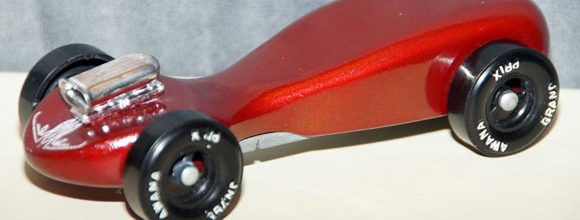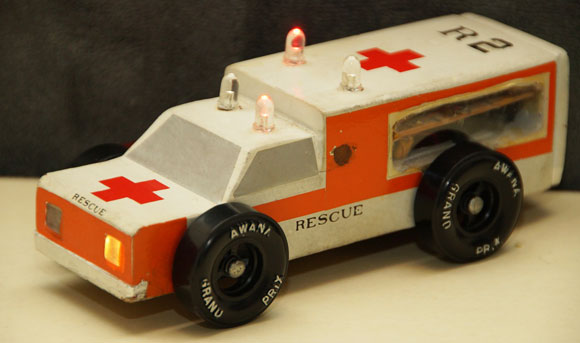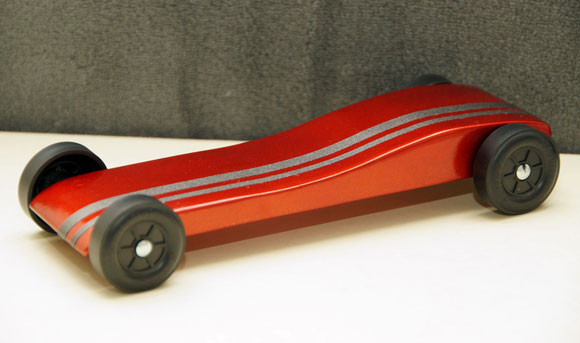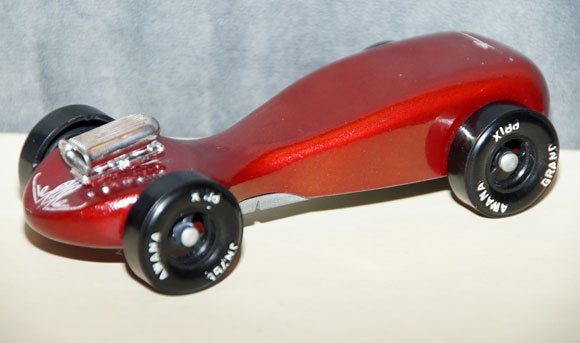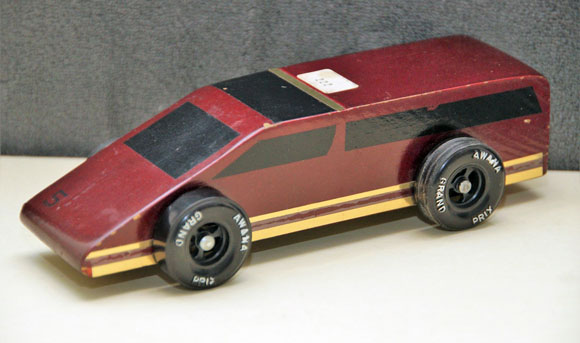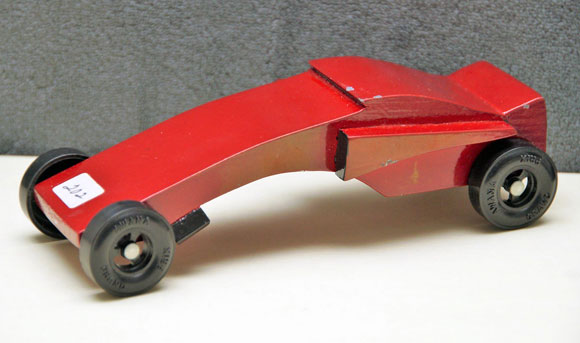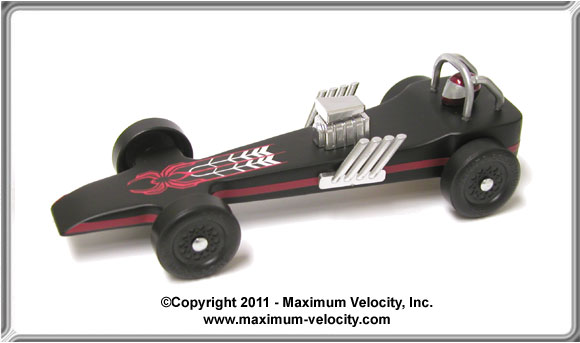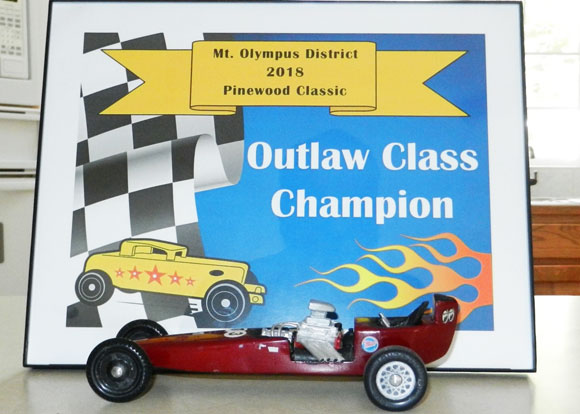In this Edition:
– Editor’s Notes
– Feature Article: Did Tom and Ray Give Good Pinewood Derby Car Advice?
– Humor
– Product Showcase: Car Plans 10 and Speed to the Finish – $5.00 off
– Pinewood Derby Car Showcase
– Pinewood Derby Memory: Pinewood Derby Winner 45-Years in the Making
– Q&A
Editor’s Notes
Revell Ceases US Operations
Hobbico, the parent company of Revell filed bankruptcy in January of this year. On April 13, 2018, Revell ceased US operations and the Illinois offices were closed.
Revell had an agreement with BSA to sell Revell’s line of pinewood derby products as officially sanctioned BSA products. With the closure of US operations, this agreement is likely defunct.
For several years, PineCar, PinePro, and Revell products were commonly available in hobby and craft stores, but only Revell products were officially sanctioned by BSA. After existing Revell inventories are sold, only PineCar and PinePro products will be readily available in hobby and craft stores. This will likely lead to increased sales at scout stores and on-line retailers of official BSA supplies.
MV Basic & Wedge Car Kits
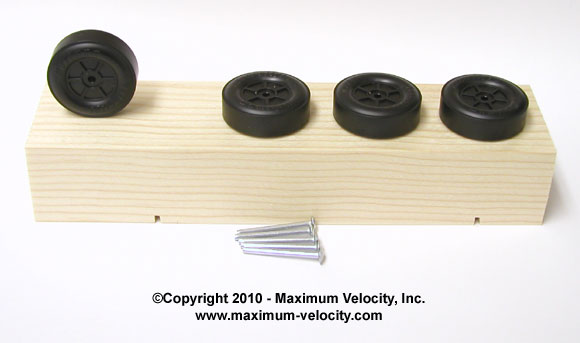
– Quality Block – Unlike the blocks provided by some organizations, our blocks are soft, northwestern pine blocks, cut precisely to 7 inches long, 1-3/4 inches wide, and 1-1/4 inches tall. These dimensions, as well as the axle slots accurately duplicate the dimensions of standard pinewood derby blocks from BSA and PineCar.
– Simple Axle Preparation – Don’t worry about filing off flaws, or losing hub caps. Our Speed Axles have no burrs or crimp marks, and install without hub caps. With or without polishing, they are ready to go. We supply five, so you have a spare.
– Quality Wheels – Forget cheap, out of round wheels. Our MV wheels are top-quality wheels. You will not be disappointed with the quality of these wheels.
So, if your organization does not mandate a particular kit type, consider our MV Basic Car Kits or MV Wedge Car Kits. We also offer bulk packs of MV kits in Pre-cut Shapes.
Inventory Clearance Sale
We are clearing inventory on several items including:
– Tungsten & Tundra Weights
– Formula One, Barracuda, and Vector car kits
We don’t have many remaining, so don’t delay.You can find these items Here.
Can We Help?
If we can help you in any way with your pinewood derby project, or if you have any feedback regarding this newsletter, please Contact Us.
Feature Article
Car Talk – Did Tom and Ray Give Good Pinewood Derby Car Advice?
By Randy Davis
I have been a fan of the radio show “Car Talk” for many years. I listened to it each Saturday until it went off the air due to the failing health of Tom Magliozzi, the older brother. Reruns can now be heard on NPR, as well as via podcast; so I have listened to many older episodes that I had missed the first time they aired.
If you have not listened to the show, it was a car advice call-in show, with a lot of laughing, tongue-in-cheek humor, and self-deprecation by the hosts Tom and Ray Magliozzi (also known as “Click and Clack the Tappet Brothers). Usually, when a caller gave their question, there was a lot of back and forth bantering before some (generally) good advice was given. In my opinion, the show was popular because the hosts were so “real” – they did not hide who they really were: just a couple of real guys with good and bad traits, just like the rest of us.
Recently, an episode was re-aired where a lady called in asking advice on an upcoming pinewood derby race. Naturally, I was very interested to hear what advice was given: was it good or bad? I’ll provide my thoughts at the end after you have had a chance to read the transcript of the discussion.
As a caveat, remember that tongue-in-cheek humor is a big part of the show, so don’t be offended by a few of the comments. Also, I tried to transcribe the episode verbatim, but there is a lot of over-talking and interrupting which doesn’t transcribe well.
Caller: How you guys doing?
Ray: Good, good; who is this?
Caller: I’m Cathy L. I’m the den leader of Wolf Den 7, Pack 35 in Tualatin, Oregon.
Ray: So, you’re a den mother.
Caller: I’m a den mom. I have the uniform to prove it.
Tom: Is that Girl Scouts?
Caller: Ha, that is Cub Scouts; little second grade boys.
Tom: Oh, boys.
Caller: And so, I just happened to be sanding the wheels of the pinewood derby car with my variable speed sander.
Ray: Ah ha.
Caller: And phoning a few parents for just some friendly advice.
Ray: Oh, on how to make the pinewood derby thing go faster?
Caller: That’s the one. Of course, my son was involved totally in the whole process.
Ray: Well I was involved in the pinewood derby thing for many years having seen two boys through Cub Scouts.
Caller: Is this where it all got started?
Ray: This is where, hah. Actually, my younger boy wasn’t interested. The older boy, Louie, was interested in Cub Scouts and he saw it through, right to Boy Scouts.
Tom: Did he?
Ray: Then they threw him out, some moral charge …
Laughing
Ray: But anyway …
Caller: It’s a parental thing.
Ray: I was disappointed, I guess, that the parents got involved to the extent that they did. After all, it’s designed so that the kids can learn.
Caller: Oh, get serious!
Laughing
Caller: Get a grip.
Tom: Right, I mean can you see this six-year-old kid with a belt sander?
Ray: What this thing is for those people that don’t know; the Cub Scouts nationwide have a pinewood derby where they give these kids a block of wood.
Tom: It’s a little thing.
Ray: The block of wood is like 6 x 2 x2. Is that what it is?
Caller: That’s right.
Ray. Okay, and they give a couple of wheels and some little nails to attach the wheels to the block. And you can do anything you want with this thing with a piece of sandpaper and a broken piece of glass. (Laughing) And you can basically sand and smooth and whatever, and you can lubricate the axles (which are nails) with graphite.
Caller: Right.
Ray: And you can paint it, and you can do anything else like that, but you can’t add weight to it except more than a couple of quarters worth of weight, right?
Caller: Uh, you can … That’s my question. Boy you’re smart.
Tom: (Laughing) That’s your question?
Caller: The car can weigh up to five ounces.
Tom: Oh, and the block of wood weighs one ounce.
Caller: Well the block of wood when you get it weighs about three, but you gotta … you know, you monkey with it …
Tom: You sand it down.
Caller: Right, sand it down so each car kinda takes on its own …
Ray: So, you want to know where to embed the lead weights.
Caller: Well I, let me …
Tom: Should there be any lead weights at all…
Caller: Any lead weights, it can be any weights at all …
Tom: And where should you put them …
Caller: Well, and the track is about 20 feet, the first, maybe 1/3 or a little more is a 45-degree drop.
Ray: Right, so they give you the head of steam.
Caller: Right.
Ray: So, you launch the cars from the top.
Tom: Then it levels out.
Caller: And it levels out and the cars are almost always equal going off the drop, but you get on the straight away, then the men are separated from the boys literally.
Tom: Yeah. Oh, well you know why they are equal? Galileo figured that out.
Caller: Yeah.
Tom: Because they are falling, they are falling, they are in free fall, almost.
Ray: Falling bodies.
Tom: As we know free fall doesn’t matter if you drop a ton of feathers or a ton of bricks.
Caller: But, we have learned through a multitude of telephone calls and research that what does matter the most is getting as close as possible to the 5 ounces. Because if your car weighs 4.9 ounces, forget it.
Tom: Sure, cause it’s 1/2MV2
Caller: Or something like that.
Ray: That’s just Kinetic Energy.
Tom: Because that is how much kinetic energy it has. And that is equivalent…, MV is momentum.
Ray: Yeah so, what.
Caller: You’re making that up.
Tom: M, M, Mass!
Ray: So, what does momentum have to do with velocity?
Caller: Well my question is …
Tom: F=MA
Laughing
Ray: What it means is that the equation K=1/2MV2 that your car has the potential to do more damage when it crashes into something, if it is heavier.
Tom: Correct.
Ray: But it is not going to go any faster.
Tom: I’ve never understood this. I flunked 801 twice.
Ray: Professor Teeje
Tom: Professor Laszlo Teeje. “Mister Magliozzi, I going to do you a favor. I’m going to give you an F. ”
Ray: Again.
Tom: Again. And I said: “Professor Teeje, thank you. God knows I’ve earned it.”
Ray: And God bless.
Laughing
Tom: But I was good in chemistry, if that matters.
Ray: Well, yeah it didn’t matter to him.
Tom: In math, I wasn’t okay at math.
Ray: So, has anyone given you a reason why this makes a difference. Because I don’t quite see it.
Tom: I’ve never understood it.
Caller: Well it’s basic statistical observation. Cars that are 4.9 don’t finish as high as cars that are 5.0.
Tom: Yeah, the heavier cars win. There is no question about that.
Caller: Now in our ever-increasing quest as concerned parents…
Laughing
Ray: Concerned about “winning” parents.
Caller: To beat the living you know what out of all those other snotty little second grade boys.
Laughing
Tom: We’re going to kick some butt here boys.
Ray: Kicking some pinewood butt.
Caller: That’s the attitude. Okay, we want to know is it better to equally distribute the weight, front and back, center it, which is what some of the fliers from Boy’s Life tell you; or put it all in the back. Which is my vote.
Ray: First of all, this is not the first time I’ve thought about this.
Tom: You were in the derby.
Ray: I’ve made many a pinewood car.
Tom: Yeah, and what did you do?
Ray: Lost every time. Because I refused…
Caller: Then why am I talking to you guys?
Ray: Because I refused to believe that the weight made that much of a difference.
Caller: So, your recommendation would be contour versus weight?
Tom: I would go for the reduced weight, just have four wheels, no body.
Caller: So, when my son comes in dead last, I explain to him …
Tom: You explain to him, “Those morons …”
Ray: Well you do want to reduce what we call the “feather effect”.
Caller: Ah, the feather effect.
Ray: Yeah, if your car is too light then it will be affected adversely, it’s like dropping a feather and a golf ball.
Caller: It will be blown all over the track.
Ray: It will be blown all over the place. That may be the only reason for adding the weight. That is the only reason.
Caller: Yeah.
Ray: To reduce that effect; to reduce the adverse effects of the aerodynamics.
Tom: Does Galileo refer to this, or does 801 call it the “feather effect”?
Ray: No, but I do.
Laughing
Caller: Brilliantly, I might add.
Tom: You and feathers …
Ray: Heh, heh, watch this stuff. Good luck Kathy, and look; we want a full written report.
Caller: With photos.
Ray: With photos of the photo finish. We’re counting on it.
Tom: And God knows you’re going to need a lot of luck, and I’m giving it to you right now.
Ray: And if we can figure of any other way for you to cheat, we’ll call you.
Caller: Amen.
Laughing
Caller: See ya.
Ray: The spirit of America is alive and well.
Okay, well that discussion certainly wandered around quite a bit, but let’s try to pick out some nuggets that we can look at further:
- The caller said that by observation, heavier cars are faster, but this was discounted by Ray.
- Weight positioning was the question – but not really answered.
- K=1/2MV2 is given as a pertinent equation by Tom.
- F=MA is given as a pertinent equation by Tom.
- Ray stated that the “Feather Effect” is the only reason to add weight.
Heavier Cars are Faster
We don’t need to spend much time on this one. The caller was correct that heavier cars are faster. This is commonly observed but was also the subject of an experiment which proved that weight improves speed (up to a point). This experiment was documented in Volume 16, Issue 2 at:
https://www.maximum-velocity.com/v16i2/
Effect of Weight Positioning
As most racers know, on a typical pinewood derby track with a ramp, a transition, and a flat section, rear weighting provides more energy, and thus more speed. This was the subject of several experiments, one of which I ran in 2004. The results clearly showed that rear weighting improves performance.
Does K=1/2MV2 Apply?
K in this formula is kinetic energy, while M is mass and V is velocity. Kinetic energy is the energy that the car has while it is in motion.
Once on the flat, the car would have a measurable amount of kinetic energy. Due to friction and air resistance, V would get smaller, thus the kinetic energy would get smaller.
What the equation tells us is that mass increases the kinetic energy of the car, thus, more energy is required to stop the car. So, the car will continue to roll longer if the mass is greater. Another way to look at this was stated by Ray: “What it means is that the equation K=1/2MV2, that your car has the potential to do more damage when it crashes into something, if it is heavier.”
However, the equation does not tell us how to make the car go faster, as it does not show us how to make V larger.
Does F=MA Apply?
Force=Mass x Acceleration shows us that the force applied by a pinewood derby car is increased with an increase in mass and is also increased by how fast the car accelerates. Again, the formula does not help us learn how to increase speed (or acceleration – the rate at which speed changes).
Both of the above equations are useful in calculating the forces on a pinewood derby car, but they do not specially help us increase the speed. They do however, point to the main forces that must be overcome by the car builder: friction and air resistance. These are the forces that limit speed and acceleration.
Feather Effect
The effect that Ray is referring to is where a feather and a bowling ball (or another heavy smooth object) is dropped from the same height. According to Galileo, in a vacuum, the feather and ball would drop at the same rate since gravity works on both objects in the same way. But in the presence of an atmosphere, the feather falls much more slowly because of the air.(1)
There is some application of Ray’s effect in pinewood derby racing. Air resistance does slow down the car as it traverses the track. The effect is much less than friction, but it is measurable. I have performed several experiments on the aerodynamic effect, which can be found at the links below:
Frontal Cross Section Testing – Volume 16, Issue 9
Fenders – Volume 13, Issue 1
Air Guides – Volume 17, Issue 3
Wind Tunnel – Volume 5, Issue 9
Conclusion
When Car Talk was still a live show, it was a great resource for automobile advice. But for advice on pinewood derby racing, I think you would be better served by giving us a call at Maximum Velocity!
(1) For a fascinating video showing the proof of Galileo’s theory, check out this video on youtube.
Humor
Cutting Class
A teacher was reprimanding a teenager in the hall. “Do you mind telling me whose class you’re cutting this time?” “Like,” the young teen replied, “uh, see, okay, like it’s like I really don’t like think like that’s really important, y’know, like because I’m y’know, like I don’t like get anything out of it.”
“It’s English class, isn’t it?” replied the smiling teacher.
Product Showcase
Car Plans 10 and Speed to the Finish: $5.00 off
Our newest plan booklet, “Car Plans 10” is now available with plans for the Funny Car, the Low-Rider GT, and the Dominator design. Our speed tip booklet, “Speed to the Finish” can be combined with Car Plans 10 for a discount.
But through November 13, 2018, you can get an additional $5.00 off the Car Plans 10 and Speed to the Finish combo. To take advantage of this limited time offer, add “Car Plans 10 and Speed to the Finish” to your cart and use coupon code OCT31NL during checkout.
Pinewood Derby Car Showcase
Today’s cars are from Corey Drotzur of Goldsboro, North Carolina.
Ambulance
The Ambulance was built many years ago using a modified model train crossing guard circuit card, 9V battery, red LEDs, and white bulbs. It’s pretty beat up from years of show and tell. It took first place design at the local Awana Grand Prix and third place design at the Regional. View the ambulance with working lights.
Striped Jaguar
The Striped Jaguar is a minor modification of the MV Jaguar plan in Car Plans 9. This is a standard bulk MV slotted kit; however, as you can tell, I cut from the opposite side and drilled axle holes. The paint is DupliColor Metalcast over filler primer.
Shorty
Shorty is quite old, but people love it because of the pretty paint, minimal decals, and cute spoon design. It’s so short a bar zinc weight takes up the entire bottom. It’s definitely no speed demon with such a short wheelbase.
Lumina Van
The legacy Lumina van was a good representation of the original Chevy Lumina APV. Not the quickest or best looking, but it managed.
Arch Support
Arch Support is a creation just to be different and mix it up. A bit too high to be stable, but you have to admit it is different.
Share Your Car with Our Readers
Do you have a car you would like to “show off” to our readers? If so, send us a photo of your car along with a description of any special features to: in**@**************ty.com
Please include your full name. If selected, we will include the photo and description in this newsletter.
Photos must be sent by e-mail in JPG format (minimum size of 640×480, maximum size of 1280 x 960). Please shoot photos from the front left of the car, similar to the orientation of car shown at:
For better focus, keep the camera four or five feet away from the car, and then use the camera’s zoom to fill the frame with the car. Also, use a solid (preferably white) background for the photo.
Send only one photo per car, unless an additional photo is needed to adequately show a feature. Also, only one car per subscriber per year please. Thanks.
Pinewood Derby Memory
Pinewood Derby Winner 45-Years in the Making
The year was 1973 when my youngest brother came to me asking if I would help him build a Pinewood Derby car. Together we made a dragster. Even now, I remember the look on my brother’s face when we arrived at the race event. To us, the car we built was the envy of all the other Cub Scouts. While it was the best-looking car, it was also the slowest. Somehow the car ended up in a box of my keepsake treasures. Each time I came across it, I would tell myself I need to give this back to my brother.
Early in 2018, my wife read in the local paper’s “Community Events Calendar” about an Adult Pinewood Derby. When she told me about it, I immediately thought about the dragster. This was my opportunity to build my own racer. With excitement, I paid the entry fee, which came with a Pinewood Derby kit and the rules. As I read the rules, I discovered there was an Outlaw Class. A single thought came to mind—redemption! I could resurrect my brother’s old dragster and rebuild it into an Outlaw Class racer; then after the race, I would send it back to him with photos!
I set out researching speed secrets on the internet. I downloaded articles and watched YouTube videos. Then, I searched for my brother’s 1973 vintage dragster. I knew it was somewhere around the house. The dragster had seen better days; the front axle was broken, one wheel was lost, along with the steering wheel, headers, and air scoop. Work started by listing items needed to rebuild the old car into an awesome Outlaw racer.
I decided to use the original wheels for the front and use new wheels from a Pinewood Derby kit for the rear. I stuck it together to see how this “Frankendragster” would look. To my surprise and delight, the age and past workmanship, along with bouncing around in my box of keepsake treasures, made this baby a natural “rail rider”. It even had one wheel in the front that didn’t touch the ground — a speed secret picked up from the Internet!
The axles were polished to a mirror finish. Maximum weight for the Outlaw Class was 6-ounces. Getting it up to the maximum weight was a bit of a challenge, requiring the old dragster be gutted to make way for the needed weight. This involved removing fish line sinkers and lead shot and hollowing out the body. Finishing the running gear and weight issues, my attention turned to the fit and finish. I decided to keep the original paint job. Missing parts were crafted of wood, including the steering wheel and engine intake. Headers were made out of leftover bamboo skewers from a past barbeque.
There it was, back to (better than) its original glory of yesteryear. My brother’s dragster resurrected from my box of keepsake treasures — ready to race. The day of the event was exciting for this old-school to new-school racer. The old dragster weighed in at the exact maximum weight. Watching it rocket down the track for the first time in forty-five years was just fantastic. It ran far better than I ever expected; straight down the track — not a wobble or wiggle. The picture tells the results.
All of this was done without my brother’s knowledge. I live in Washington State and he lives in Idaho. A presentation stand was made for his awesome winning Outlaw racer to be displayed in front of the award. My wife helped to pack it for mailing and off it went without his knowledge. He called about his mystery package. We had a good laugh and talked for some time reminiscing about the long-ago race and memories of years past — priceless times.
I’d be remiss in not thanking the event sponsor for giving me the opportunity to reconnect with past memories as well as making new ones. This 2018 Adult Pinewood Derby Event was the inaugural fund-raiser for Mt. Olympus District of the Chief Seattle Council, Boy Scouts of America. The event was exciting and fun thanks to dedicated volunteers who are a valuable asset to the local community. I plan to be there for the second annual race.
By Bruce Nielsen
Do you Remember?
If you have a pinewood derby story that is funny, unusual, sad, heart-warming, etc., please send it to me in an e-mail. Don’t worry about literary polish. We will edit as needed before publishing.
If your story is used, you will receive a $10 coupon in May of 2019.
Q&A
I recently learned my sons’ Cub Scout Packmaster has been buying Maximum Velocity pre-drilled blocks and MV Precision Wheels and Axles. According to your website, the wheels and axles are flawless. I was wondering what if any preparation is recommended for the wheels and axles (relative to BSA kits)?
The MV axles do not have burrs and the head is pre-beveled, so you do not need to do any filing. I recommend polishing from 1500 grit and up, and then use the diamond polish. You can polish the bore of the wheels with bore polish, and of course lubricate thoroughly.
The one feature of the BSA wheel that our wheel does not have is a coned inner hub. If desired, you can use the Pro-Hub tool to bevel the inner hub.
From inserting and removing axles/wheels multiple times my axle slots are now loose. Do you have any recommended repair technique for this? I have to glue the axles (per the rules) anyway. Is this enough to ensure I will not have a problem?
The first thing I would try is using a small paint brush to brush some water (just enough to get the wood wet) into the slot. The water will cause the wood fibers to swell up, tightening the slot.
If there is paint or a lot of graphite in the slot, then the water may not work. The next step is to cut a 1/8-inch-wide strip of paper, use a small brush to apply a very thin layer of white glue on the paper, and then glue it to one side of the slot. If the slot is very loose, use a thicker (heavier) paper.
Want Answers?
Do you have a pinewood derby-related question? If so, e-mail us your question.We answer all questions by e-mail, but not every question will appear in the Q&A section of the newsletter.
Back Issues
Are you a new subscriber, or have you missed some of the previous newsletters? Don’t miss out; all of the issues for Volume 5 through Volume 18 are posted on our web site.
Newsletter Contributions
We welcome your contributions. If you would like to contribute an article, a web site review, a speed tip, or a pinewood derby memory, please e-mail us.
Subscription Information
The Pinewood Derby Times is a free e-newsletter focused on pinewood derby racing. It is published biweekly from October through March.
If you haven’t already done so, please forward this issue to your pinewood derby friends. But please don’t subscribe your friends. Let them decide for themselves. Thanks.
If this newsletter was forwarded to you, why not subscribe to receive this newsletter. There is no cost, and your e-mail address is safe, as we never sell or share our distribution list.
To subscribe, send a blank e-mail to
pi*********************@*******st.com
You will receive a confirmation e-mail. Reply to the confirmation e-mail and you will start receiving the Pinewood Derby Times with the next issue.
Randy Davis, Editor, Pinewood Derby Times
E-Mail: in**@**************ty.com
(C)2018, Maximum Velocity, Inc. All rights reserved. Please do not reprint or place this newsletter on your web site without explicit permission. However, if you like this newsletter we grant permission, and encourage you to e-mail it to a friend.
Maximum Velocity disclaims any personal loss or liability caused by utilization of any information presented in this newsletter.
The Pinewood Derby Times is not specific to, and is not affiliated with the Boy Scouts of America, YMCA, Awana, or any other organization.
(R)Maximum Velocity is a registered trademark of Maximum Velocity, Inc.
(R)Pinewood Derby is a registered trademarks of the Boys Scouts of America.
(R)Awana is a registered trademark of Awana Clubs International.
All other names are trademarks of their respective owners.

